Few WordPress features offer more return on your learning investment than block patterns.
WORDPRESS
Is it the Best WooCommerce Theme for Your Site?

In this Shoptimizer review, we’re going to be taking a look at all of the features this popular WooCommerce theme has to offer.
It’s known for being one of the fastest WooCommerce themes around, but does it really live up to the hype? Keep reading to learn the pros and cons of using Shoptimizer for your site, as well as the pricing, so that you can decide for yourself whether it’s the right theme for you.
Try Shoptimizer today and get access to amazing features, blazing-fast speeds, and superior customer support.
Shoptimizer Review
-
Ease of Use
-
Stability
-
Customer Service
-
Price
Summary
Shoptimizer is a lightning-fast WooCommerce designed to help you get the most out of your online store. It’s packed full of features to provide a great user experience and ensure high conversion rates. Try Shoptimizer today!
Pros
- Easy-to-use dashboard
- Drag and drop builder
- Discounts often available
- CommerceKit and other plugins available
- Known for great customer service and technical support
- Super quick page load speeds
Cons
- If you don’t use CommerceKit then many of the features are unavailable
- No free trial
Shoptimizer Review: Overview & Features
As you might imagine, a WordPress theme of this caliber has plenty of features and options to choose from.
From ensuring that your brand identity is front and center to ensuring that you can be found on Google, the Shoptimizer WooCommerce theme does it all.
Let’s take a look at the main features on offer.
Drag and Drop Page Builder
When you’re putting together your website, you want it to be as sleek as possible – which, if you have no web design experience, can seem tricky.
The Elementor drag-and-drop page builder on offer by Shoptimizer helps you put together pages easily. It even has a range of professionally designed pre-built templates you can use to get you started.
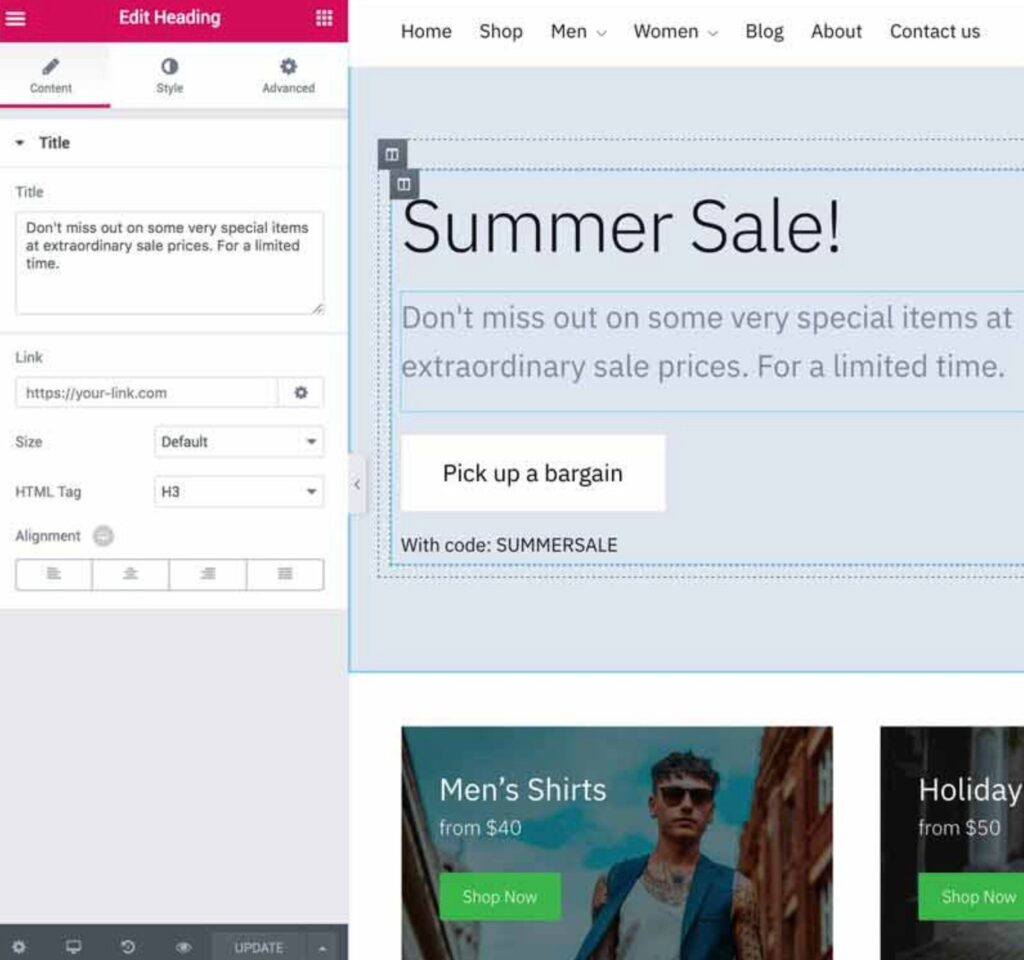
This easy-to-use page builder enables you to create unique layouts without needing to employ any coding or special skills.
Simply drag and drop the different elements into place until you have created the perfect page.
Shoptimizer Review: Checkout Process
If you want people to shop with you, then it stands to reason you want the checkout process to be as smooth as possible.
Research shows that delays with your website loading or a clunky checkout process can put customers off. This is why Shoptimizer has a distraction-free checkout process that your online customers can follow.
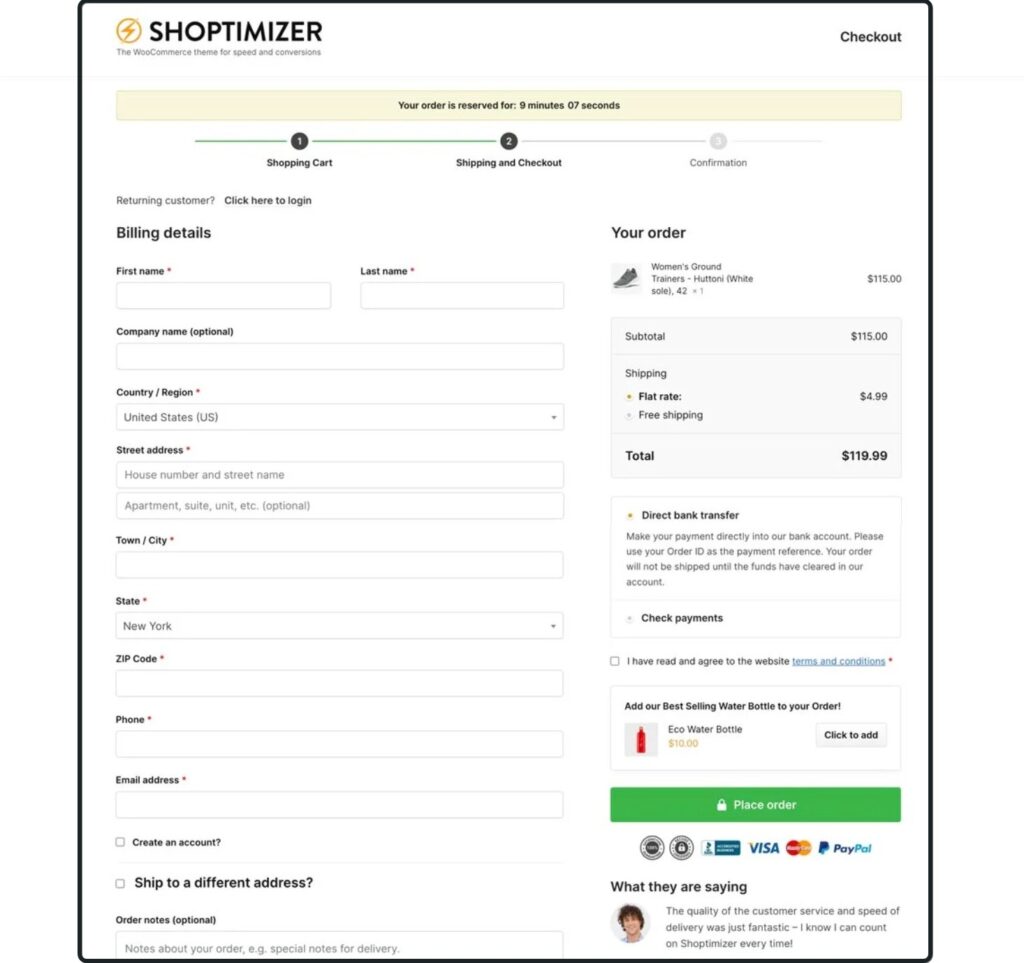
The checkout page also includes trust badges and customer testimonials to help maximize conversions.
SEO Enhancements
Shoptimizer is packed full of SEO enhancements to help boost organic traffic to your store.
It includes an additional field for product categories to enable search engines to crawl your site efficiently. All pages are optimized for mobile first, with optimized images and page load times.
Conversion Optimization Features
When you have an e-commerce business, it makes sense that you want to have a sales funnel to help you convert as many clicks into sales as possible. Shoptimizer helps with this in a number of ways.
Fast-loading websites, easy-to-use page builders, and even things like their Single Product Conversion feature are in place to help you generate sales.
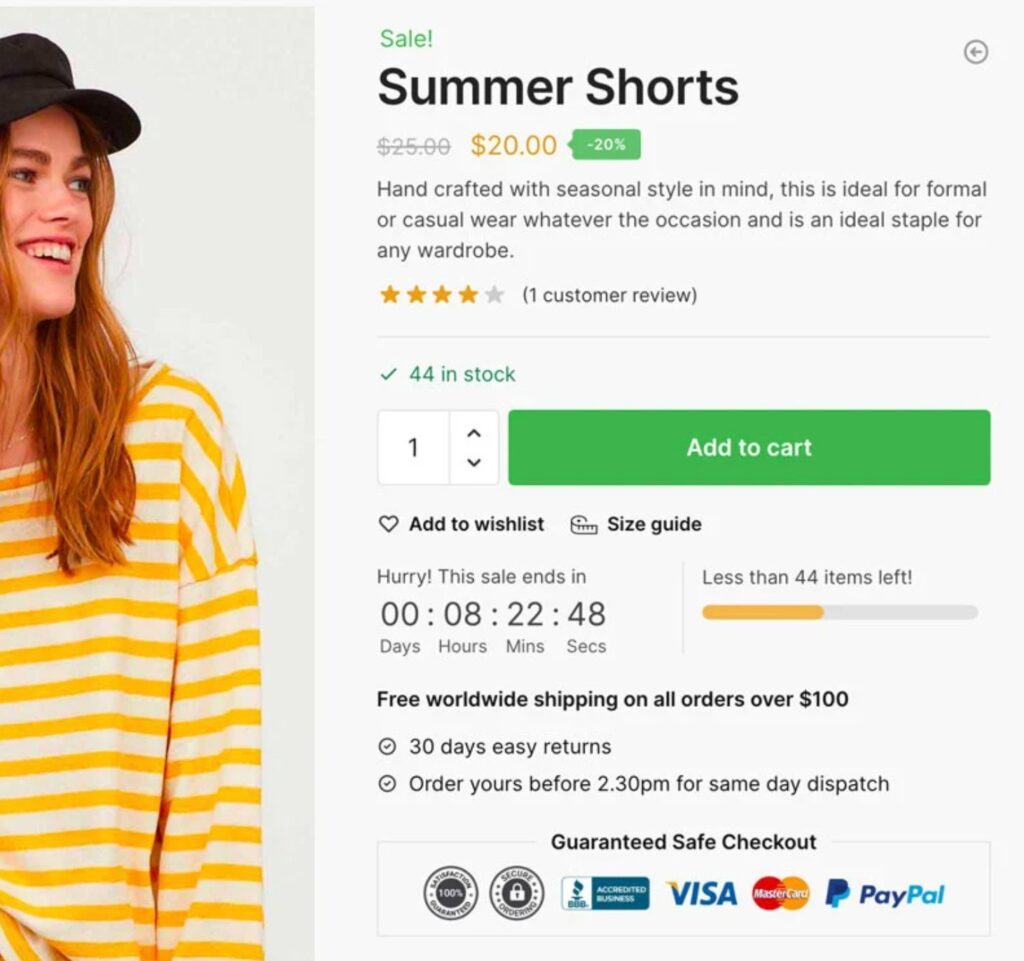
As well as the distraction-free checkout, Shoptimizer also includes additional product information on the product page.
This includes shipping information, returns, and how many products are left to add a sense of urgency. It essentially answers all of the customer’s questions in one place.
Shoptimizer Speeds

A fast theme is important for preventing lost sales, and Shoptimizer is known for being one of the fastest WooCommerce WordPress themes.
Faster speed helps gain you a higher SEO ranking. This results in fewer lost sales and a more efficient business—exactly what every business owner strives for.
To boost loading speed, Shoptimizer includes automatic minification of the main CSS. A critical CSS stylesheet ensures no waiting time and a perfectly rendered site for each and every visitor.
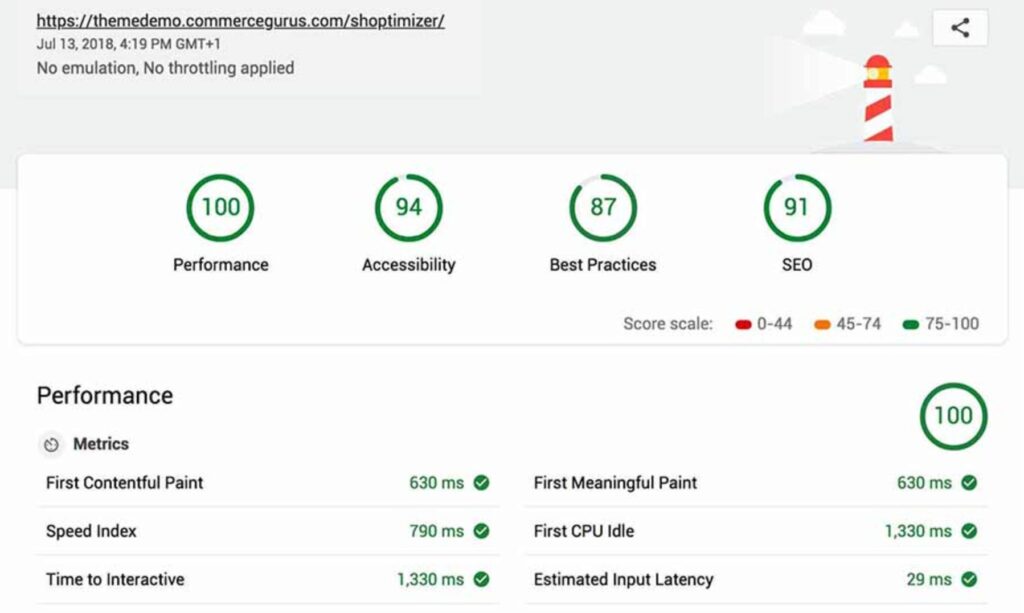
If your WooCommerce theme is bloated with a large range of unnecessary features, it can slow down your site and have a negative effect on business.
Choosing Shoptimizer is a great way for online store owners to ensure a fast-loading site with the features their customers really need.
Customization Options
The customization features within Shoptimizer allow you to alter settings quickly.
From layout, header, navigation, colors, and fonts, Shoptimizer is easily tailored to your needs and preferences.
The widgets tab gives you access to various features like audio players, image galleries, or calendars. The location for your feature can be chosen too. Side, top, and center bars are available.
You can also have extra features and changes to ensure the theme looks just how you want in keeping with your brand identity.

Make your theme your own by adding/removing sidebars and footers. You can even customize how your blog looks in terms of width and position of all of these.
The Typography section of your Shoptimizer dashboard can be used to set up fonts throughout your website. Here, you can choose fonts for different sections.
This includes headings, titles, paragraphs within a post, and even the main body. The fonts are completely customizable, with the option to change letter spacing, color, and size.
Shoptimizer allows you to choose the layout for your whole website, including what appears on your website’s header. Choose the top padding, search design layout, and even sticky navigation.
This helps to ensure your layout is exactly how you want. Changing it easily means you can even tweak it if you feel a change would lead to more sales.
Is Shoptimizer Easy to Use?
While it is always a matter of personal opinion on how easy (or otherwise) something is to use, most users agree that Shoptimizer is pretty easy.
You’ll probably find it easy to get to grips with if you are already familiar with WordPress. Still, with so many online tutorials available, you can get by even as a complete beginner.
The ability to use drag and drop without needing to resort to coding and in-depth skills helps both experts and beginners alike.
Shoptimizer has a user-friendly admin panel accessible through your WordPress admin dashboard. Most things can be done from here.
However, if there is something that you find tricky, then there are plenty of help guides in the extensive knowledge base to get you started.
Most people generally agree that Shoptimizer is something that even beginners can use without too many worries.
Is Shoptimizer Good for SEO?
Whatever type of business you are running and whoever your target audience is, being able to rely on organic traffic is a must – which is why SEO is so important.
The great news is that Shoptimizer is great for SEO and includes several features that can put you ahead of the competition, including ensuring that your pages load quickly.
A built-in checker within Shoptimizer lets you see just how optimized each page is within your website and any changes you need to make to improve this.
Additionally, the Shoptimizer theme allows you to add content to each product category page – which can be great for SEO when used correctly.
Shoptimizer Review: Pros & Cons
As you might imagine, there are plenty of pros and cons with a WooCommerce theme as extensive as this. What is good for someone might not be what you’re looking for, but having an idea of what they offer is still good.
Pros:
- Easy-to-use dashboard
- Drag and drop builder
- SEO-friendly
- Discounts often available
- CommerceKit and other plugins available
- Arguably the fastest ecommerce theme around
- Known for great customer service and technical support
- Super quick page load speeds
Cons:
- If you don’t use CommerceKit then many of the features are unavailable
- No free trial
Shoptimizer Pricing
Shoptimizer has no free options and must be purchased, but it is often available with healthy discounts.
It is priced at $99 but is available with a 50% off reduction in line with their current promotion. The subscription gives you unlimited updates for one year.
Shoptimizer Alternatives
If Shoptimizer doesn’t seem like it is for you for one reason or another, you’ll be glad to know that plenty of alternatives are out there.
The trick is to ensure you do your research and compare them side-by-side, so you can be sure that when you do choose a WooCommerce theme, you have made the right decision.
Astra

Astra is one of the most popular WooCommerce themes around. It’s known for being super fast, lightweight, and extremely customizable. This makes it a great choice for anyone wanting to build an e-commerce store.
One of the best things about the Astra Theme is that it has a free version, so you can try it for size before you commit.
Astra has a range of features, including give you customizer controls, so you can change how each product page looks. However, you should keep in mind you won’t have access to all the features with the free version.
Read our in-depth Astra 3.0 review for everything you need to know about this powerful theme!
Divi
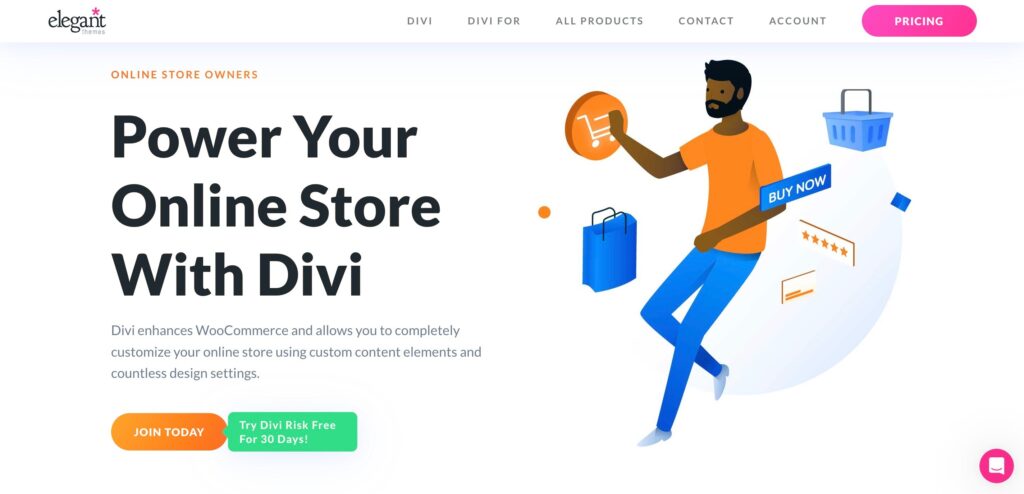
Divi by Elegant Themes often appears in lists of leading WooCommerce themes alongside Shoptimizer, because it has a range of similar features.
However, one thing that many people comment on is the page load speeds – which can be slower at times.
Recent updates have improved the speed, but many people worry that this is something that could change again in the future, so most certainly something to keep in mind.
Read our Divi Review to find out more about this versatile WordPress and WooCommerce theme.
Shoptimizer Review: Verdict
So it’s time for the verdict… Is Shoptimizer worth the money?
Yes! It’s easy to see why Shoptimizer is so popular. It’s a great choice for anyone looking for a budget-friendly yet fully optimized ecommerce WordPress theme with the capabilities needed to form an essential part of your WooCommerce store.
The only downside is that there is no free version available. Still, with plenty of offer discounts, if you’re looking for a fast WooCommerce theme that offers everything, then this is definitely one to try.
WORDPRESS
Smooth Transition: A Comprehensive Guide to Migrating from WooCommerce to Shopify

Are you considering migrating from WooCommerce to Shopify but feeling overwhelmed by the process? Fear not! This comprehensive guide is designed to walk you through every step of the migration journey, ensuring a smooth transition for your online store. Whether you’re looking to capitalize on Shopify’s user-friendly interface or seek better scalability for your growing business, this guide has covered you. Let’s dive into the essential steps and strategies for seamlessly migrating from WooCommerce to Shopify.
Understanding the Migration Process
Assessing Your Current WooCommerce Setup
Before embarking on the migration journey, take a thorough inventory of your current WooCommerce setup. Identify your products, categories, customers, and any customizations you’ve made to your store. This assessment will provide a clear roadmap for transferring your data to Shopify without missing any crucial elements.
Choosing the Right Shopify Plan
Shopify offers a range of plans tailored to different business needs, from basic to advanced. Take the time to evaluate your requirements and select the plan that aligns best with your budget and growth goals. Whether you’re a small startup or an established enterprise, Shopify has a plan to suit your needs.

Preparing Your Data for Migration
Backing Up Your WooCommerce Data
Before initiating the migration process, creating a backup of your WooCommerce data is essential. This ensures that you have a safety net in case anything goes awry during the transition. Export your product listings, customer information, order history, and other relevant WooCommerce data.
Importing Your Data into Shopify
Once you’ve backed up your WooCommerce data, it’s time to import it into Shopify. Shopify provides tools and apps that streamline the data migration process, making it easy to transfer your products, customers, and orders seamlessly. Follow the step-by-step instructions provided by Shopify to upload your data accurately.
Additionally, if you’re migrating from WooCommerce to Shopify, it’s crucial to understand the specific steps involved in this process. Ensure that you follow the recommended procedures and utilize the available resources to facilitate a smooth transition.

Designing Your Shopify Store
Choosing a Theme
One of the perks of migrating to Shopify is access to a wide range of professionally designed themes. Browse Shopify’s theme library to find a design that reflects your brand identity and complements your products. Whether you prefer a minimalist aesthetic or a bold, eye-catching layout, Shopify has a theme to suit your style.
Customizing Your Theme
Once you’ve selected a theme, customize it to align with your brand’s look and feel. Shopify’s intuitive drag-and-drop editor makes it easy to tweak your theme’s layout, colors, fonts, and imagery without any coding knowledge required. Experiment with different customization options until you’re satisfied with the overall design of your Shopify store.

Configuring Your Settings and Features
Setting Up Payment Gateways
Shopify offers a variety of payment gateways to accommodate different customer preferences. Configure your preferred payment methods, including credit cards, PayPal, Apple Pay, and more, to provide a seamless checkout experience for your customers. Ensure that your payment gateways are integrated securely to protect sensitive customer information.
Managing Shipping Options
Streamline your shipping process by configuring your shipping settings in Shopify. Set up shipping zones, rates, and fulfillment preferences to ensure accurate shipping costs and delivery times for your customers. Shopify’s built-in shipping tools make it easy to manage your shipping logistics efficiently.

Launching Your Shopify Store
Testing Your Store
Before going live with your Shopify store, thoroughly test its functionality to identify and resolve any issues. Conduct test transactions, navigate the checkout process, and review your store’s performance on different devices and browsers. Address any bugs or discrepancies to ensure a smooth launch for your Shopify store.
Announcing Your Launch
Once you’re satisfied with the functionality and design of your Shopify store, it’s time to announce your launch to the world. Generate excitement among your audience by promoting your new store on social media, email newsletters, and other marketing channels. Offer exclusive deals or discounts to incentivize customers to explore your new Shopify storefront.

Post-Migration Optimization
Monitoring Performance Metrics
After migrating to Shopify, monitor your store’s performance metrics to gauge its success. Track key metrics such as traffic, conversion rates, and average order value to identify areas for improvement. Use Shopify’s built-in analytics tools or integrate third-party analytics platforms to gain valuable insights into your store’s performance.
Continuously Improving Your Store
Optimize your Shopify store based on the insights gleaned from your performance metrics. Experiment with different marketing strategies, product offerings, and user experience enhancements to maximize your store’s potential. Continuously seek customer feedback and iterate on your store’s design and functionality to stay ahead of the competition.
Conclusion
In conclusion, migrating from WooCommerce to Shopify can be a manageable task. By following the steps outlined in this comprehensive guide, you can navigate the migration process with confidence and ease. From assessing your current setup to launching your new Shopify store and beyond, this guide equips you with the knowledge and tools to make a smooth transition. Embrace Shopify’s opportunities for scalability, flexibility, and growth, and watch your online business thrive in its new home.

Related
WORDPRESS
WordPress Block Patterns Give You Superpowers – WordPress.com News
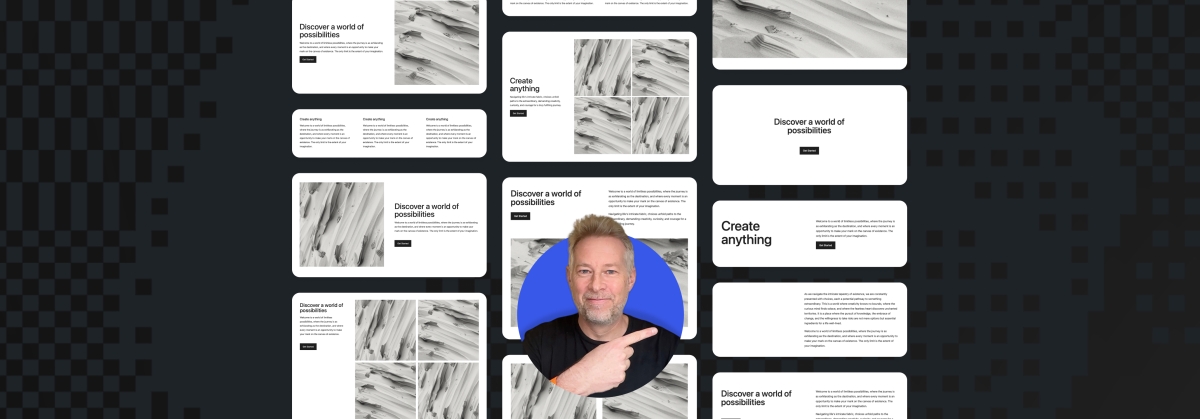
With the power of block patterns you’ll be a WordPress superstar in no time, whether you’re an establish pro or just starting out. Block patterns are professionally designed layouts that you can add your site in a single click. What makes them especially powerful is that once they’re inserted, you can edit and customize every aspect. (Or, you can leave them be!)
In today’s Build and Beyond video, Jamie Marsland walks you through everything you need to go to become a block pattern expert, in under four minutes.
Get started on your site today with a free trial:
Join 110.2M other subscribers
WORDPRESS
Astra Theme Coupon 2024 (Apr) [40% Discount, Save $400]
![Astra Theme Coupon 2024 (Apr) [40% Discount, Save $400] Astra Pricing Plans on discounts](https://articles.entireweb.com/wp-content/uploads/2024/04/1713797772_611_Astra-Theme-Coupon-2024-Apr-40-Discount-Save-400.png)
Do you want higher discount on kartra?? We are excited to announce that our Astra Theme Coupon Codes are now available!
Astra is a well-liked, multifunctional WordPress theme that is frequently used by bloggers, companies, and online shops among the other themes.
It is a thin, quick, adaptable, and somewhat pricey theme that offers customers a simple base on which to create their websites.
So if you are thinking about buying astra theme, This article will be a gold mine for you.
In this article, we are sharing every single detail related to Astra Theme Coupon, So you can get the maximum discount on their plan.
Astra Offers Summary:
Total Coupons
7 Offers
Maximum Discount
Up to 50% OFF
Maximum Saving
Up to $400
Astra Plans For Offer
Annual and Lifetime
Money-Back Guarantee Offer
14 Days
New Offers on Astra-
Lastest Astra Theme Coupons
Best for Individual Site or Bloggers.
Astra Pro Coupon – For Lifetime Plan Value for Money
Get All Astra Pro Features with 100+ Templates and Unlimited Sites License. This One-time Investment can save you hundreds of dollars later.
Best for Individual Site or Bloggers, Business Site. (Most Selected)
Best Plan for Freelancers and New Web Designers.
Best Plan for Freelancers and New Web Designers. (Our Recommendation for Business)
Best Plan for Agencies and StartUps.
Best Plan for Agencies and StartUps.
Astra New Year 2024 Sale
Astra is celebrating 1 Million Installations and Offering up to 63% Off on their Plans. (Default offer from the WP Astra)
Save Big with Astra Special Sale on Every Plan. [Maximum Saving]
Note: Some coupon codes may have restrictions and are only valid for specific packages.
Easy Steps To Follow-
How To Use Coupon To Get Astra Discount
Here are some simple steps that you can follow and get discount on any Astra theme plans:
Step 1: Choose the Astra Theme package that you wish to purchase. There are three options available: Astra Pro, Essential Bundle, and Growth Bundle.
![Astra Theme Coupon 2024 (Apr) [40% Discount, Save $400] Astra Pricing Plans on discounts](https://articles.entireweb.com/wp-content/uploads/2024/04/1713797772_611_Astra-Theme-Coupon-2024-Apr-40-Discount-Save-400.png)
Step 2: Add the desired package to your cart and proceed to checkout.
Step 3: On the checkout page, you will find a coupon code box where you can enter the coupon code.
Step 4: Enter the coupon code in the designated field and click on the “Apply Coupon” button.
![Astra Theme Coupon 2024 (Apr) [40% Discount, Save $400] Astra Theme Coupon Code on checkout](https://articles.entireweb.com/wp-content/uploads/2024/04/1713797773_676_Astra-Theme-Coupon-2024-Apr-40-Discount-Save-400.png)
Step 5: Once the coupon code is applied, you will see the discount reflected in the final price.
Step 6: Complete the payment process and make the purchase.
It’s that simple! By using the Astra Promo Code, you can save a considerable amount on your purchase of the Astra Theme. Make sure to use the coupon code before it expires to take advantage of the discount.
Choose The Best Plan For You-
Astra Theme Plans With Discount
Here we are sharing all the details of astra theme plans, so you can choose the best plan for you and get dicount:
Astra Pro offers hundreds of customization options to simplify and accelerate the process of creating your desired website. Normally priced at:-
- $59 per year or
- $299 for a lifetime,
But you can take advantage of our Astra theme coupon Codes and save $12 annually or $72 for a lifetime purchase by getting Astra Pro for $47 per year or $227 for a lifetime.
With Astra Pro, you will have access to numerous features that will elevate your website to new heights. These include:-
- Advance Header Builder,
- Advance Blog Layouts,
- Sticky Header,
- Custom Layouts & Hooks,
- Advance Typography,
- Advanced Colors Options,
- Mega Menu,
- Global Color Palettes,
- Advance Footer Builder,
- WooCommerce Controls,
- Native AMP Support,
- White Label,
- Product Updates,
- Premium Support,
- Unlimited Website Usage,
- Extensive Training,
- Risk-Free Guarantee.
The Essential Bundle from Astra Theme offers a complete solution for building exceptional websites. This Bundle comes with premium website templates and addons to enhance your preferred page builder.
Essential Bundle have two payment option:
- a one-time payment of $677.
- an annual payment of $137.
But you can take advantage of our Astra Coupon Code and save $32 annually or $172 for a lifetime purchase.
With the Essential Bundle, you will have access to all the necessary tools to create stunning and functional websites that stand out from the competition, including:-
- Astra Pro (i.e. all features of Astra Pro),
- 180+ Premium Starter Templates,
- WP Portfolio Plugin,
- Choice of One Page Builder Addon,
- Ultimate Addons for Elementor OR Ultimate Addons for Beaver Builder,
- Product Updates,
- Premium Support,
- Unlimited Website Usage,
- Extensive Training,
- Risk-Free Guarantee.
The Growth Bundle from Astra Theme is the most sought-after choice among users, providing a complete set of tools required to establish and expand your online business.
Growth Bundle have two payment option:
- An annual payment of $187
- A one-time payment of $937
But you can take advantage of our Astra Discount Code and save $62 annually or $7312 for a lifetime purchase.
The Growth Bundle grants access to everything you need to take your business to the next level, including:-
- Everything in Essential Bundle, and
- Convert Pro Plugin,
- Schema Pro Plugin,
- Ultimate Addons for Beaver Builder,
- Ultimate Addons for Elementor,
- Spectra Pro (Coming Soon),
- SkillJet Academy Membership,
- Our Future Products,
- Product Updates,
- Premium Support,
- Unlimited Website Usage,
- Extensive Training,
- Risk-Free Guarantee.
Points To Keep in Mind-
Astra Terms and Policy For Coupons
This section refers to the terms and conditions associated with the use of coupons offered by Astra Theme. so here are some points that you should keep in mind while applying coupon on Astra plans:
- Coupon Validity: Coupons may have a specific expiration date and can only be redeemed within that time frame.
- Eligibility: Some coupons may only be available to new customers or certain users, while others may be available to everyone.
- Coupon Usage: Coupons may only be used once per customer and may not be combined with any other offers or discounts.
- Discount Amount: Coupons may provide a fixed dollar amount off the purchase price or a percentage off.
- Product Restrictions: Some coupons might only be usable for a particular product or set of products.
- Payment Method: Some coupons might only be redeemed with specific payment options, like PayPal or a credit card.
- Terms and Conditions: Coupons are subject to Astra Theme’s terms and conditions, which include but are not limited to its refund policy and privacy policy.
- Changes and Updates: Astra Theme reserves the right to modify or discontinue coupons at any time without prior notice.
Our Opinion-
Conclusion- WP Astra Theme Coupon 2024
Astra is a robust and adaptable WordPress theme that is ideal for online stores, enterprises, and bloggers. It is the best option for anyone wishing to create a website that looks professional thanks to its responsive design, user-friendly interface, and vast selection of pre-designed themes.
Users can build up an online store quickly and easily with the help of the rich customization options and WooCommerce connection available in the Astra Pro version.
An excellent option for anyone wishing to develop a website, Astra’s many plans offer a solution for various demands and budgets.
With our Astra theme discount code, you’ll be able to build a beautiful, fast, and user-friendly website that meets all of your needs without breaking the bank. Don’t miss out on this opportunity to take advantage of our Astra discount and create the website of your dreams.
Frequently Asked Question
Quries Related To Astra Coupon
How can I use the Astra discount code?
The Astra Coupon Code is a unique promotional code that Astra Theme provides to its clients. Simply enter the code in the corresponding field during checkout when ordering Astra Pro or Growth Bundle to use it. Your total will be adjusted automatically to reflect the savings.
How frequently are new Astra promo codes released?
Astra discount codes are frequently provided during special sales and occasions, such holidays or the introduction of new products. The Astra website should always be checked, though, for the most recent deals and discounts.
How much discount will I get with the Astra Coupon Code?
The amount of discount you receive with an discount code varies depending on the offer. You can expect to save anywhere from 10% to 50% off the regular price of Astra Pro or Growth Bundle.
Can I use the Astra theme discount Code on renewals or upgrades?
Yes, the Astra discount code can be used for both renewals and upgrades of Astra Pro or Growth Bundle.
How many coupons I can use on single purchase?
On Astra Theme, you can apply only one coupon on single purchase, and you can apply your next coupon on another purchse
Does Astra Provide any Lifetime offer?
Yes, Astra provide lifetime offer on both Pro and bundle plan, so you can make one time payment and enjoy lifetime.
Does Astra Offeres any student discount?
No, astra does not offer any student discount, as a student you can use our astra coupon and get discount on any plan you want.
-

 PPC5 days ago
PPC5 days ago19 Best SEO Tools in 2024 (For Every Use Case)
-
SEARCHENGINES7 days ago
Daily Search Forum Recap: April 17, 2024
-

 SEO7 days ago
SEO7 days agoAn In-Depth Guide And Best Practices For Mobile SEO
-
SEARCHENGINES6 days ago
Daily Search Forum Recap: April 18, 2024
-
SEARCHENGINES5 days ago
Daily Search Forum Recap: April 19, 2024
-

 MARKETING6 days ago
MARKETING6 days agoEcommerce evolution: Blurring the lines between B2B and B2C
-

 SEO6 days ago
SEO6 days ago2024 WordPress Vulnerability Report Shows Errors Sites Keep Making
-

 WORDPRESS5 days ago
WORDPRESS5 days agoHow to Make $5000 of Passive Income Every Month in WordPress






![Astra Theme Coupon 2024 (Apr) [40% Discount, Save $400] Astra Pricing Plans on discounts](https://articles.entireweb.com/wp-content/uploads/2024/04/1713797772_611_Astra-Theme-Coupon-2024-Apr-40-Discount-Save-400-400x240.png)
![Astra Theme Coupon 2024 (Apr) [40% Discount, Save $400] Astra Pricing Plans on discounts](https://articles.entireweb.com/wp-content/uploads/2024/04/1713797772_611_Astra-Theme-Coupon-2024-Apr-40-Discount-Save-400-80x80.png)
![Elementor Pro Discount (Apr 2024) [70% OFF, Save $150] Elementor Coupon](https://articles.entireweb.com/wp-content/uploads/2024/04/1713729377_Elementor-Pro-Discount-Apr-2024-70-OFF-Save-150-400x240.png)
![Elementor Pro Discount (Apr 2024) [70% OFF, Save $150] Elementor Coupon](https://articles.entireweb.com/wp-content/uploads/2024/04/1713729377_Elementor-Pro-Discount-Apr-2024-70-OFF-Save-150-80x80.png)




